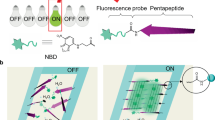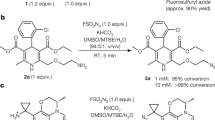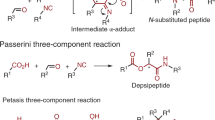Abstract
Peptide synthesis on cellulose using SPOT technology allows the parallel synthesis of large numbers of addressable peptides in small amounts. In addition, the cost per peptide is less than 1% of peptides synthesized conventionally on resin. The SPOT method follows standard fluorenyl-methoxy-carbonyl chemistry on conventional cellulose sheets, and can utilize more than 600 different building blocks. The procedure involves three phases: preparation of the cellulose membrane, stepwise coupling of the amino acids and cleavage of the side-chain protection groups. If necessary, peptides can be cleaved from the membrane for assays performed using soluble peptides. These features make this method an excellent tool for screening large numbers of peptides for many different purposes. Potential applications range from simple binding assays, to more sophisticated enzyme assays and studies with living microbes or cells. The time required to complete the protocol depends on the number and length of the peptides. For example, 400 9-mer peptides can be synthesized within 6 days.
This is a preview of subscription content, access via your institution
Access options
Subscribe to this journal
Receive 12 print issues and online access
$259.00 per year
only $21.58 per issue
Buy this article
- Purchase on Springer Link
- Instant access to full article PDF
Prices may be subject to local taxes which are calculated during checkout








Similar content being viewed by others
References
Sewald, N. & Jakubke, H.-D. Peptides—Chemistry and Biology 1st edn. (Wiley-VCH, Weinheim, Germany, 2002).
Paschke, M. Phage display systems and their applications. Appl. Microbiol. Biotechnol. 70, 2–11 (2006).
Westerlund-Wikstrom, B. Peptide display on bacterial flagella: principles and applications. Int. J. Med. Microbiol. 290, 223–230 (2000).
Yan, X. & Xu, Z. Ribosome-display technology: applications for directed evolution of functional proteins. Drug Discov. Today 11, 911–916 (2006).
Merrifield, R.B. Solid phase peptide synthesis. I. The synthesis of a tetrapeptide. J. Am. Chem. Soc. 85, 2149–2154 (1963).
McKay, F.C. & Albertson, N.F. New amine-masking groups for peptide synthesis. J. Am. Chem. Soc. 79, 4686–4690 (1957).
Carpino, L.A. Oxidative reaction of hydrazines. IV. Elimination of nitrogen from 1,1-disubstituted-2-arenesulfonhydrazides. J. Am. Chem. Soc. 79, 4427–4431 (1957).
Anderson, G.W. & McGregor, A.C. t-Butyloxycarbonylamino acids and their use in peptide synthesis. J. Am. Chem. Soc. 79, 6180–6183 (1957).
Carpino, L.A. & Han, G.Y. The 9-fluorenylmethoxycarbonyl amino-protecting group. J. Org. Chem. 37, 3404–3409 (1972).
Houghten, R.A. General method for the rapid solid-phase synthesis of large numbers of peptides: specificity of antigen–antibody interaction at the level of individual amino acids. Proc. Natl. Acad. Sci. USA 82, 5131–5135 (1985).
Pellois, J.P. et al. Individually addressable parallel peptide synthesis on microchips. Nat. Biotechnol. 20, 922–926 (2002).
Geysen, H.M., Meloen, R.H. & Barteling, S.J. Use of peptide synthesis to probe viral antigens for epitopes to a resolution of a single amino acid. Proc. Natl. Acad. Sci. USA 81, 3998–4002 (1984).
Frank, R. Spot synthesis: an easy technique for positionally addressable, parallel chemical synthesis on a membrane support. Tetrahedron 48, 9217–9232 (1992).
Kramer, A. & Schneider-Mergener, J. Synthesis and screening of peptide libraries on continuous cellulose membrane supports. Methods Mol. Biol. 87, 25–39 (1998).
Toepert, F. et al. Combining SPOT synthesis and native peptide ligation to create large arrays of WW protein domains. Angew. Chem. Int. Ed. Engl. 42, 1136–1140 (2003).
Heine, N. et al. Synthesis and screening of peptoid arrays on cellulose membranes. Tetrahedron 59, 9919–9930 (2003).
Blackwell, H.E. Hitting the SPOT: small-molecule macroarrays advance combinatorial synthesis. Curr. Opin. Chem. Biol. 10, 203–212 (2006).
Hilpert, K., Hansen, G., Wessner, H., Volkmer-Engert, R. & Hohne, W. Complete substitutional analysis of a sunflower trypsin inhibitor with different serine proteases. J. Biochem. (Tokyo) 138, 383–390 (2005).
Kramer, A. et al. Molecular basis for the binding promiscuity of an anti-p24 (HIV-1) monoclonal antibody. Cell 91, 799–809 (1997).
Kramer, A. et al. Spot synthesis: observations and optimizations. J. Pept. Res. 54, 319–327 (1999).
Weiser, A.A. et al. SPOT synthesis: reliability of array-based measurement of peptide binding affinity. Anal. Biochem. 342, 300–311 (2005).
Molina, F., Laune, D., Gougat, C., Pau, B. & Granier, C. Improved performances of spot multiple peptide synthesis. Pept. Res. 9, 151–155 (1996).
Geysen, H.M., Barteling, S.J. & Meloen, R.H. Small peptides induce antibodies with a sequence and structural requirement for binding antigen comparable to antibodies raised against the native protein. Proc. Natl. Acad. Sci. USA 82, 178–182 (1985).
Houghten, R.A. et al. Generation and use of synthetic peptide combinatorial libraries for basic research and drug discovery. Nature 354, 84–86 (1991).
Zander, N., Beutling, U., Dikmans, A., Thiele, S. & Frank, R. A special cellulose membrane support for the combinatorial and parallel synthesis of peptide libraries suitable for the SC2-type manufacturing of high density multi-purpose chemical micro-arrays. in Peptides 2004: Proceedings of the Third International and 28th European Peptide Symposium (eds. Flegel, M. et al.) 405–406 (2005).
Hilpert, K., Hansen, G., Wessner, H., Schneider-Mergener, J. & Hohne, W. Characterizing and optimizing protease/peptide inhibitor interactions, a new application for spot synthesis. J. Biochem. (Tokyo) 128, 1051–1057 (2000).
Hilpert, K., Volkmer-Engert, R., Walter, T. & Hancock, R.E. High-throughput generation of small antibacterial peptides with improved activity. Nat. Biotechnol. 23, 1008–1012 (2005).
Hilpert, K. & Hancock, R.E.W. Use of luminescent bacteria for rapid screening and characterization of short cationic antimicrobial peptides synthesized on cellulose by peptide array technology. Nat Protocols (in the press).
Kamradt, T. & Volkmer-Engert, R. Cross-reactivity of T lymphocytes in infection and autoimmunity. Mol. Divers. 8, 271–280 (2004).
Reineke, U. et al. Mapping protein–protein contact sites using cellulose-bound peptide scans. Mol. Divers. 1, 141–148 (1996).
Hilpert, K., Winkler, D.F.H. & Hancock, R.E.W. Cellulose-bound peptide arrays: preparation and applications. Biotech. Genet. Eng. Rev. 24 (in the press).
Fields, G.B. & Noble, R.L. Solid phase synthesis utilizing 9-fluorenylmethoxycarbonyl amino acids. Int. J. Pept. Prot. Res. 35, 161–214 (1990).
Krchnak, V., Vagner, J. & Lebl, M. Noninvasive continuous monitoring of solid-phase peptide synthesis by acid-base indicator. Int. J. Pept. Protein Res. 32, 415–416 (1988).
Gausepohl, H. & Behn, C. Automated synthesis of solid-phase bound peptides. in Peptide Arrays on Membrane Support (eds. Koch, J. & Mahler, M.) 55–68 (Springer, Berlin, Heidelberg, 2002).
Bowman, M.D., Jacobson, M.M., Pujanauski, B.G. & Blackwell, H.E. Efficient synthesis of small molecule macroarrays: optimization of the macroarray synthesis platform and examination of microwave and conventional heating methods. Tetrahedron 62, 4715–4727 (2006).
Takahashi, M., Ueno, A. & Mihara, H. Peptide design based on an antibody complementarity-determining region (CDR): construction of porphyrin-binding peptides and their affinity maturation by a combinatorial method. Chem. Eur. J. 6, 3196–3203 (2000).
Acknowledgements
We are grateful for financial assistance from the Applied Food and Materials Network and the Canadian Institutes of Health Research. R.E.W.H. was supported by a Canada Research Chair award. K.H. was supported by a fellowship from the Canadian Institutes of Health Research. We thank R.A. Klady for the critical proofreading of the manuscript.
Author information
Authors and Affiliations
Corresponding author
Ethics declarations
Competing interests
The authors declare no competing financial interests.
Rights and permissions
About this article
Cite this article
Hilpert, K., Winkler, D. & Hancock, R. Peptide arrays on cellulose support: SPOT synthesis, a time and cost efficient method for synthesis of large numbers of peptides in a parallel and addressable fashion. Nat Protoc 2, 1333–1349 (2007). https://doi.org/10.1038/nprot.2007.160
Published:
Issue Date:
DOI: https://doi.org/10.1038/nprot.2007.160
This article is cited by
-
In silico identification of two peptides with antibacterial activity against multidrug-resistant Staphylococcus aureus
npj Biofilms and Microbiomes (2022)
-
The rumen eukaryotome is a source of novel antimicrobial peptides with therapeutic potential
BMC Microbiology (2021)
-
Assessing biofilm inhibition and immunomodulatory activity of small amounts of synthetic host defense peptides synthesized using SPOT-array technology
Nature Protocols (2021)
-
Antimicrobial host defence peptides: functions and clinical potential
Nature Reviews Drug Discovery (2020)
-
Hyaluronic Acid Fibres in Solid Phase Peptide Synthesis — Their Properties, Morphology and Stability
Fibers and Polymers (2020)
Comments
By submitting a comment you agree to abide by our Terms and Community Guidelines. If you find something abusive or that does not comply with our terms or guidelines please flag it as inappropriate.



